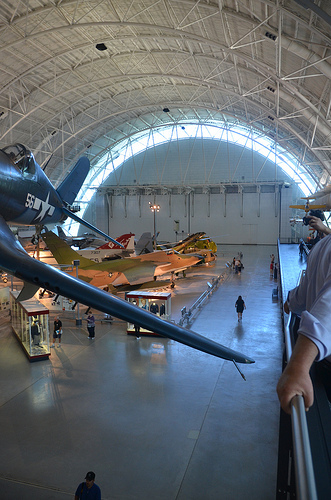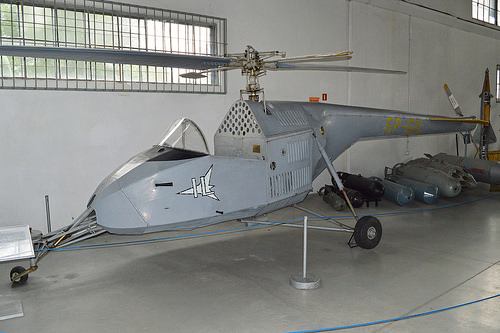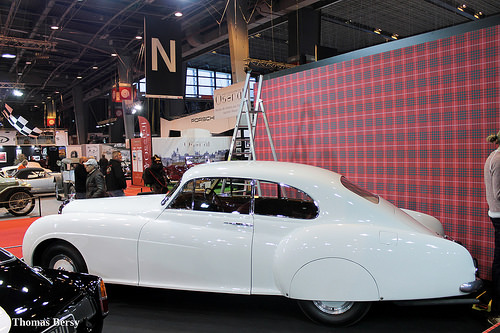Verify out these aluminum prototype machining pictures:
Steven F. Udvar-Hazy Center: main hall panorama (F-four Corsair, et al)

Image by Chris Devers
Quoting Smithsonian National Air and Space Museum | Vought F4U-1D Corsair:
By V-J Day, September 2, 1945, Corsair pilots had amassed an 11:1 kill ratio against enemy aircraft. The aircraft’s distinctive inverted gull-wing style permitted ground clearance for the huge, 3-bladed Hamilton Regular Hydromatic propeller, which spanned much more than 4 meters (13 feet). The Pratt and Whitney R-2800 radial engine and Hydromatic propeller was the largest and one particular of the most potent engine-propeller combinations ever flown on a fighter aircraft.
Charles Lindbergh flew bombing missions in a Corsair with Marine Air Group 31 against Japanese strongholds in the Pacific in 1944. This airplane is painted in the colors and markings of the Corsair Sun Setter, a Marine close-support fighter assigned to the USS Essex in July 1944.
Transferred from the United States Navy.
Manufacturer:
Vought Aircraft Business
Date:
1940
Country of Origin:
United States of America
Dimensions:
All round: 460 x 1020cm, 4037kg, 1250cm (15ft 1 1/8in. x 33ft five 9/16in., 8900lb., 41ft 1/8in.)
Materials:
All metal with fabric-covered wings behind the main spar.
Physical Description:
R-2800 radial air-cooled engine with 1,850 horsepower, turned a three-blade Hamilton Regular Hydromatic propeller with strong aluminum blades spanning 13 feet 1 inch wing bent gull-shaped on both sides of the fuselage.
I.L. BZ-1 Gil ‘SP-GIL’

Image by Hawkeye UK
c/n 1.
On show in the principal display hangar at the Muzeum Lotnictwa Polskiego
Krakow, Poland.
23-08-2013
The following info is taken from the museum internet site:-
"The idea of designing and developing helicopters in Poland was born in 1946. Its author was Zbigniew Brzoska ph.D. Even so, on the way to the realisation of such a daring enterprise there stood the lack of appropriate scientific studies. The only supply of information was the aviation press concerned with technical novelties. 1st, the gathering of any details regarding this topic was undertaken. In 1947, a 3 man group was appointed. It integrated Zbigniew Brzoska, accountable for the helicopter’s engine, Bronisław Żurakowski, accountable for the main rotor and Tadeusz Chyliński, responsible for the style of fuselage, tail boom, tail rotor and undercarriage.
In 1949, the design and style studies had been completed and the building of the prototype of an experimental machine started. The assembly ended in summer the very same year. The machine received the SP-GIL, civil registration. No official name was appointed. The helicopter was developed in a "classic" configuration (a single main rotor plus a tail rotor). The main rotor, based on the American Hiller system, had two wooden principal blades and two smaller steering blades. Such a configuration ensured self-stability and decreased the control force, which significantly made steering easier.
A fabric covered fuselage had removable aluminium engine doors. The airframe was created in a type of truss, welded with steel tubes. The cockpit was created for two persons, but virtually, it was flown single handed. The nose wheel undercarriage had oleo-pneumatic shock absorbers. For propulsion, a really good German Hirth HM 504 inline engine was selected. The intermediate tail rotor gearbox, taken from the German Zundapp motorbike, was used.
In April, 1950, in-flight tests started. The helicopter test pilot was one particular of the designers – Bronisław Żurakowski. It is worth mentioning, that he had no prior experience of flying a helicopter, not to mention undertaking so as a pilot. Several distinct engines failing created the tests hard. An additional critical dilemma was the vibrations, that had been a serious mishap in helicopter improvement throughout the globe.
In 1951, as a result of many repairs, designers managed to lower vibrations by applying a particular resonance absorber to the major rotor. The designer was Zbigniew Brzoska and the builder was Bronisław Żurakowski. Nonetheless, right after the helicopter’s breakdown in 1953, tests have been suspended. The machine was repaired but received no flight certificate. In autumn 1956, the helicopter was restored, a few changes and reinforcements being introduced. In February 1957, after yet another harm, flights have been stopped and the helicopter was scrapped.
From the perspective of time, the helicopter’s building was very easy, if not primitive. It is worth noting, nevertheless, that it was just an experimental aircraft, intended to collect knowledge in the then still reasonably unknown domain of rotorcraft. In addition, it appeared as a outcome of a low-price range enterprise, in a war-tormented country, where it was tough to locate finance and resources for such experiments. As a pioneering building, it did excellently. One particular can only regret, that it did not open the way to domestic helicopter construction. Helicopter production in Poland quickly began on a grand scale, albeit on Soviet licence. It was an unfortunate turn of events for Polish aircraft industry, as it began to develop this topic virtually at the identical time as the most famous designers and producers in the planet, who faced the very same technical issues and breakdowns.
The SP-GIL helicopter never ever received an official name. In a few publications, the name BŻ-1 GIL (bullfinch) is utilised, but it is just a literary convention of sorts utilized as the type’s designation."
Bentley R-Variety Continental 1952

Image by tautaudu02
This essential early ‘A’ series R-Variety Continental graced the Bentley Motors exhibition stand at the London Earls Court Motor Show in 1952. Autocar’s reporter from the 31st October edition of the magazine exclaimed that ‘Bentley’s new continental sports saloon is an inevitable centre of attraction, as it is bound to be with the rakish lines of the H.J. Mulliner physique. This automobile is in the front rank of higher-speed machines.’
The seventh of 193 R-Sorts constructed by H.J. Mulliner and one of just 25 ‘A-series’ vehicles, this 153bhp, 4,566cc inlet-over-exhaust six-cylinder-engined car is usually bestowed with the accolade of the most desirable post-war Bentley. Autocar described the Continental as ‘a modern magic carpet annihilating wonderful distances’. When new, it was the most costly car in the world.
Resplendent in ‘Blanc Cassee’ or ‘broken White’ coachwork, BC7A proved to be such a roaring success at the Earls Court Show that it was purchased on the spot by Mexican Señor Jonel Sanielevici, who was a Paris-primarily based member of the Diplomatic Corps. He received the vehicle in France in November 1952 whereupon he promptly returned it to Mulliner for re-upholstery in British Racing Green prior to shipment to Mexico. While in Mexico, the auto was registered beneath the diplomatic quantity of 65206 for a lot of years.
In 1960 the automobile re-situated to Mexico City following its sale to Señor Alain Reynaud, from whom the Policia Judicial mysteriously seized it in 1988. It was sold by the Policia Judicial shortly afterwards to Señora Tlapanco, who bought it as a present for her son. This gentleman went on to use and treasure the automobile more than a lengthy twenty-year period. In late-2006, with only 95,000 kilometres recorded, BC7A was consigned for sale to Kidston SA in Geneva, Switzerland, and it quickly attracted a new owner, a London businessman and Bentley collector. BC7A was exported to the UK, arriving in March 2007, and was registered to quantity plate 971 XUR.
In the course of this period the owner commissioned a full ‘body-off’ restoration to be overseen by Graeme Hunt, the former Managing Director of Jack Barclay Restricted. The objective for this restoration was to preserve and ensure total authenticity and originality, resulting in the replacement of the electrical systems with a right wiring loom, renovation and recalibration of all instruments, replating of the brightwork and replacement of the Bijur lubrication technique, along with a full engine rebuild. The paintwork and upholstery were also put back to the colours and specification of the car’s original presentation at the Earls Court Motor Show.
The existing owner is primarily based in the Netherlands and has enjoyed employing the automobile at the Lauwman Concours Elegance and the ‘The Jewels in the Park’ occasion at Dyck Castle in Germany, each of which are invitation-only events.
This wonderful car enjoys the ultimate specifications sought by connoisseurs of the R-Sort Continental: a manual gearbox, lightweight seats, rear spats, aluminium window frames, and lightweight Willmot Breeden polished duraluminium bumpers with the coveted slim overriders, the latter becoming distinctive to the earliest examples. As an early automobile directly based on the prototype, BC7A is nearly 300lbs lighter in weight than the majority of the later examples.
BC7A is presented for sale with comprehensive history files and records, such as letters of interest from the Bentley Drivers’ Club and the National Motor Museum.